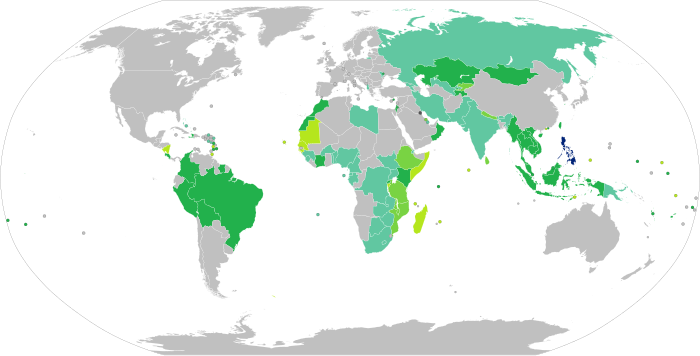Philippine passport
It is issued by the Department of Foreign Affairs (DFA) and Philippine diplomatic missions abroad, with certain exceptions.Passports were ordered to be printed in Filipino for the first time under President Diosdado Macapagal, to be subsequently implemented under his successor, Ferdinand Marcos.[7] Foreign Secretary Alan Cayetano signed the implementing rules and regulations (IRR) of the new Philippine Passport Act on October 27, 2017.The Department of Foreign Affairs is mandated under the law to establish and maintain an online application portal and Electronic one-stop shop to digitize passport applications and authorizes it to provide offsite and mobile passport services outside of the consular offices and foreign service posts.The new law requires setting up special lanes to ease application for senior citizens, overseas Filipino Worker, PWDs, pregnant women, minors aged 7 years old and below, single parents, and other exceptional cases.On August 15, 2016, the new generation e-passport was released by the Department of Foreign Affairs with advanced security features such as the upgraded microchip to capture the personal data of the applicant, invisible ultraviolet (UV) fluorescent ink and thread, and elaborate design when subject to UV light.[15] Aside from making the new e-passport tamper-proof, each leaf of the 44-page document depicts Philippine artifacts, cultural icons, historic places, renowned tourist destinations, and even lyrics of the national anthem in the pre-Hispanic Baybayin script used to write Tagalog.A letter of instruction restricted the issuance of passports to members of the Philippine diplomatic service, although this was relaxed in 1981 with the official lifting of martial law.In 1983, there were orders from the Ministry of Foreign Affairs not to issue any passports to the family of opposition senator Benigno Aquino Jr.[17] In the late 1980s and early 1990s, passports were stamped with limitations prohibiting travel to South Africa (because of apartheid) and Lebanon (because of the civil war).Passports were previously stamped prohibiting travel to Iraq due to the ongoing violence and because of the kidnapping of Angelo dela Cruz in 2004.These are currently designated by the colors maroon (regular), red (official), and dark blue (diplomatic).The passports were however not valid as a travel document and are merely symbolic to express a statement that the birds remain Philippine government property.Philippine passports are bilingual, with both issued text and information page data in Filipino followed by English translations.Persons who take advantage of overtime processing get their passports within seven days for applications for Metro Manila (DFA Consular Affairs office, ASEANA, Parañaque, Alabang Town Center, SM Megamall, and Robinsons Galleria); Region 3 (DFA Pampanga regional office, Marquee Mall in Angeles, Robinson Starmills in Pampanga and Xentro Mall in Malolos, Bulacan), Region 4-A (DFA Lucena regional office, Robinsons Lipa in Batangas, SM City Dasmariñas in Cavite, SM City San Pablo in Laguna and SM Cherry Antipolo in Rizal), Cordillera Administrative Region (Baguio City's SM City Baguio's DFA office) and 15 to 20 days in other provinces.



Countries and territories with visa-free entries or visas on arrival for holders of regular Philippine passports
biometric passportTrajanHatchingcoat-of-armsheraldic tincturesPassportDepartment of Foreign AffairsPhilippinesFilipino citizenshipminorsFilipinotravel documentidentity documentdiplomatic missionsmachine-readable passportsbiometric passportspassportsMalvar, BatangasElpidio QuirinoSpanish colonization of the PhilippinesPresidentDiosdado MacapagalFerdinand Marcos1987 constitutionbarcodesRodrigo DuterteAlan Cayetanoone-stop shopdigitizeforeign service postsoverseas Filipino Workersingle parentsBangko Sentral ng PilipinasSupreme CourtInternational Civil Aviation OrganisationGloria Macapagal ArroyoPresidential Communications Groupnational anthemBaybayinTagalogdeclaration of martial lawdiplomatic servicemartial lawBenigno Aquino Jr.Rashid LucmanMindanaoFort BonifacioSouth AfricaapartheidLebanoncivil warkidnapping of Angelo dela CruzCabinetPresident of the Philippinesdiplomatic immunityPhilippine eaglesrefugee travel documentMaritime Industry Authoritysailorscoat of arms of the PhilippinesUnited States passportbilingualEnglishLupang HinirangProverbsManilaPhilSys NumberE-PassportVisa requirements for Filipino citizensUS visaParañaqueAlabang Town CenterSM MegamallRobinsons GalleriaMarquee MallAngelesPampangaMalolosBulacanLucenaRobinsons LipaBatangasSM City DasmariñasCaviteSM City San PabloLagunaAntipoloSM City Baguiomachine-readable passportList of passport offices in the PhilippinesForeign relations of the PhilippinesPhilippine nationality lawUnified Multi-Purpose IDThe Manila TimesABS-CBN News and Current AffairsPhilippine Daily InquirerOfficial Gazette (Philippines)The Philippine StarRapplerGulf NewsKhaleej TimesYouTubeIdentity documents of the PhilippinesNational IDDriver's licensePostal IDCommunity Tax CertificateAfghanistanAlbaniaAlgeriaAndorraAngolaAntigua and BarbudaArgentinaArmeniaAustraliaAustriaAzerbaijanBahamasBahrainBangladeshBarbadosBelarusBelgiumBelizeBhutan